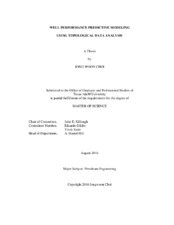| dc.description.abstract | While data analysis is one of the most important topics in diverse industries, multi-dimensional and heterogeneous reservoir data challenges reservoir engineers to analyze them. Analyzing such data is labor intensive and, sometimes the analysis results in an inaccurate performance. Furthermore, it is important to predict a well performance since maximizing profits through optimized and sustained production have become more critical due to the continuation of low oil price. Thus, precise estimation in performance of a well is necessary as it provides a guideline for decision making in production to achieve above goals. To fulfill these needs, a new approach is presented to build an event-based well performance predictive model by analyzing the microseismic data. The proposed model utilizes two machine learning algorithms, Topological Data Analysis (TDA) for the feature extraction from the microseismic data and Support Vector Machine (SVM) with a linear kernel for the supervised model training.
The contributions of the research are as follows. First, two new attributes, Average Node Value (ANV) and Fracture Distance (FRD), are introduced from microseismic data to provide an ability to consider each microseismic event’s effect on the cumulative production of the well. Second, well performance predictive models were generated utilizing these new attributes. Finally, introduced models have been compared with the model built based on the raw data through prediction performance evaluation.
Two new attributes have been generated from microseismic data, daily production data, and well trajectory data. First attribute is ANV, which is calculated based on the result shape of TDA. ANV has a physical meaning of average oil production from combinations of microseismic events with similar attributes. The second attribute is FRD, which is created through distance calculation using coordinate of microseismic events and horizontal part of well trajectory. Then, the attributes are utilized in event-based model generation. Event Representation Value (ERV) is defined to each of the microseismic events as a response variable to give them an ability to build a model. Finally, Well Representation Number (WRN) is calculated based on ERV and it is used as an indicator of production performance of the well.
A case study using the dataset collected from Middle McCowen well, Eagle Ford, Texas has been performed. From the experiment, the proposed well performance predictive model utilizing ANV and FRD outperformed a compared model built based on the raw dataset. The proposed model can be further extended to general hydraulic fractured wells by utilizing additional information such as fracture conductivity and fracture spacing information. | en |


